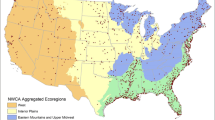Abstract
We sampled 92 wetlands from four different basins in the United States to quantify observer repeatability in rapid wetland condition assessment using the Delaware Rapid Assessment Protocol (DERAP). In the Inland Bays basin of Delaware, 58 wetland sites were sampled by multiple observers with varying levels of experience (novice to expert) following a thorough training workshop. In the Nanticoke (Delaware/Maryland), Cuyahoga (Ohio), and John Day (Oregon) basins, 34 wetlands were sampled by two expert teams of observers with minimal protocol training. The variance in observer to observer scoring at each site was used to calculate pooled standard deviations (SDpool), coefficients of variation, and signal-to-noise ratios for each survey. The results showed that the experience level of the observer had little impact on the repeatability of the final rapid assessment score. Training, however, had a large impact on observer to observer repeatability. The SDpool in the Inland Bay survey with training (2.2 points out of a 0–30 score) was about half that observed in the other three basins where observers had minimal training (SDpool = 4.2 points). Using the results from the survey with training, we would expect that two sites assessed by different, trained observers who obtain DERAP scores differing by more than 4 points are highly likely to differ in ecological condition, and that sites with scores that differ by 2 or fewer points are within variability that can be attributed to observer differences.



Similar content being viewed by others
References
Fennessy MS, Jacobs AD, Kentula ME (2007) An evaluation of rapid methods for assessing the ecological condition of wetlands. Wetlands 27:543–560
Jacobs AD (2005) Delaware rapid assessment procedure (version 2.0). Delaware Department of Natural Resources and Environmental Control, Dover, DE
Kaufmann PR, Levine P, Robison EG, Seeliger C, Peck DV, (1999) Quantifying physical habitat in wadeable streams. EPA/620/R-99/003. U.S. Environmental Protection Agency, Washington, DC
Metzeling L, Chessman B, Hardwick R, Wong V (2003) Rapid assessment of rivers using macroinvertebrates: the role of experience and comparisons with quantitative methods. Hydrobiolgia 510:39–52
Ohio Department of Natural Resources (ODNR) (1988) Ohio Wetland Inventory (OWI) database. www.dnr.state.oh.us/wetlands/mapping.htm
Roper BB, Scarnecchia DL (1995) Observer variability in classifying habitat types in stream surveys. North American Journal of Fisheries Management 15:49–53
Spencer C, Robertson AI, Curtis A (1998) Development and testing of a rapid appraisal wetland condition index in south-eastern Australia. Journal of Environmental Management 54:143–159
Stevens DL, Jensen SF (2007) Sample design, execution, and analysis for wetland assessment. Wetlands 27:515–523
Stoddard JL, Peck DV, Olsen AR, Larsen DP, Van Sickle J, Hawkins CP, Hughes RM, Whittier TR, Lomnicky G, Herlihy AT, Kaufmann PR, Peterson SA, Ringold PL, Paulsen SG, Blair R (2005) Environmental Monitoring and Assessment Program (EMAP): western streams and rivers statistical summary. EPA 620/R-05/006. U.S. Environmental Protection Agency, Washington, DC
Acknowledgments
This work was funded by the U.S. Environmental Protection Agency (EPA) through grant agreement RM-83143501, and cooperative agreements CR-831682-01 with Oregon State University, and X7-83158301-0 with Kenyon College. This article was subjected to the EPA’s peer and administrative review and approved for publication. Mention of trade names or commercial products does not constitute endorsement or recommendation for use. We thank Abby Rokosch and Rick Rheinhardt for leading the NCJ field teams and providing valuable insight on implementing rapid assessment methods. Steve Cline, Mick Micacchion, and Erica Elliot helped with field work and logistics, and Colleen Johnson made the site map figure. We also thank Letitia Grenier for helpful comments on an earlier version of this manuscript, and Erin McLaughlin for performing assessments in the Inland Bays and helping us improve the DERAP.
Author information
Authors and Affiliations
Corresponding author
Rights and permissions
About this article
Cite this article
Herlihy, A.T., Sifneos, J., Bason, C. et al. An Approach for Evaluating the Repeatability of Rapid Wetland Assessment Methods: The Effects of Training and Experience. Environmental Management 44, 369–377 (2009). https://doi.org/10.1007/s00267-009-9316-6
Received:
Revised:
Accepted:
Published:
Issue Date:
DOI: https://doi.org/10.1007/s00267-009-9316-6




